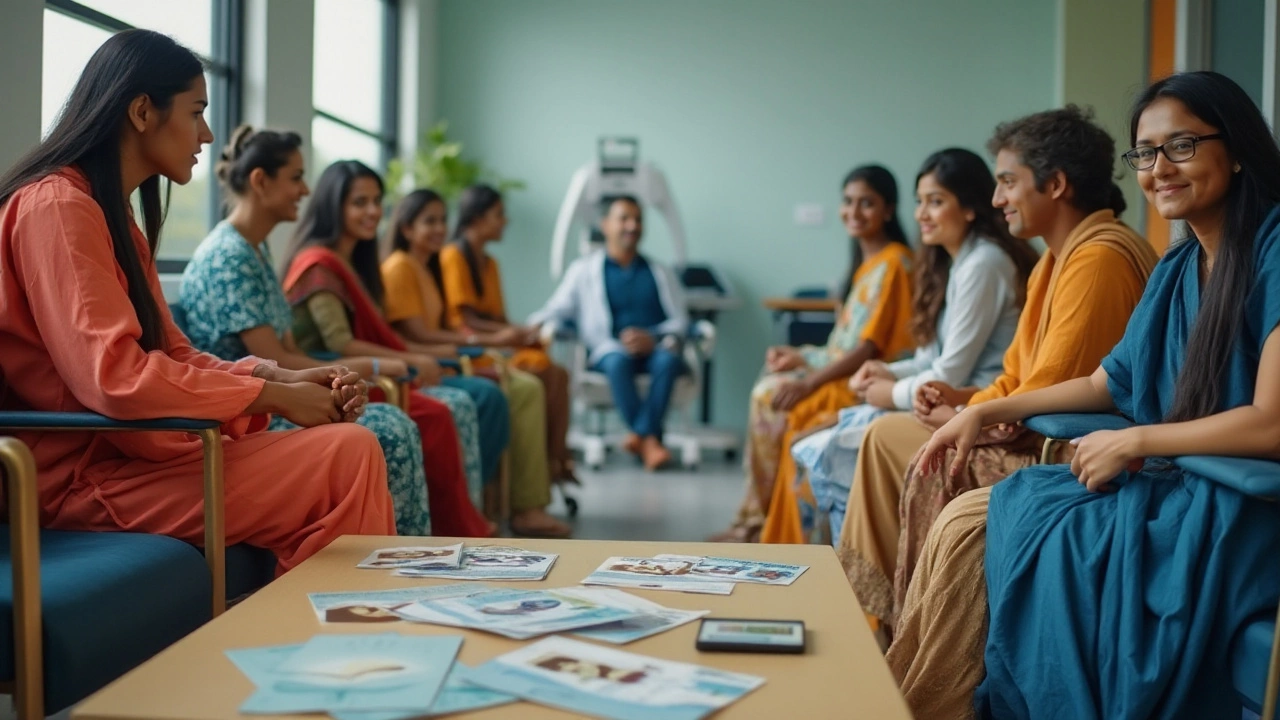Cancer is a word that tends to strike fear into anyone's heart, but it's important to remember that not all cancers carry the same weight in terms of prognosis. Some cancers show significantly higher survival rates than others, which is encouraging news. Understanding these differences can empower patients and their families as they navigate their health journeys.
In this article, we aim to shed light on the types of cancer with the highest survival rates, explore the advancements in diagnostics and treatments, and share helpful tips for prevention and support. By offering insights at the crossroads of hope and healing, we're here to provide knowledge and encouragement to those who need it most.
- Introduction to Cancer Survival Rates
- Highly Surviveable Cancers
- Diagnostic Advancements
- Treatment Options and Innovations
- Lifestyle and Prevention Tips
- Hope and Support for Patients
Introduction to Cancer Survival Rates
Cancer survival rates serve as a glimpse of hope and statistics that many patients, alongside their families, often eagerly seek out. These rates provide an idea of the percentage of people who continue to live a certain number of years after being diagnosed with cancer, such as five years. However, individuals must remember that cancer survival statistics are a complex intersection of various factors and should only serve as part of a much broader picture when considering personal prognoses. Factors such as the type of cancer, how early it is detected, and advancements in technology can play pivotal roles in these survival numbers, offering some insight into their significance and limitations.
Each type of cancer behaves differently, often affecting specific organs or tissues and spreading at various rates. This variability also means some cancers react well to treatments, while others pose significant challenges. For example, types like prostate cancer and thyroid cancer frequently show high survival rates, sometimes reaching approximately 99% at five years, primarily because they are often diagnosed early and have effective treatment options available. On the other hand, pancreatic cancer remains notorious for its significantly lower prognosis due to its late-stage detection.
It's crucial to understand how these survival rates apply. They are typically derived from large populations and might not accurately reflect individual experiences. For someone recently diagnosed, these statistics refer to outcomes from several years ago and often do not consider improvements in treatment or emerging therapies. Still, they are invaluable for medical professionals and researchers, assisting them in the development of new treatment methodologies and health policies.
Understanding Different Types of Survival Rates
Survival statistics come in a few forms, each offering a slightly different angle on what the future might hold. One might encounter terms like 'relative survival', 'disease-free survival', or 'progression-free survival', each telling a different story. Relative survival compares the survival of those with cancer to those without, whereas disease-free and progression-free survival focus on patients remaining free from cancer symptoms or showing no advancement in the disease, respectively. These distinctions are essential for patients to comprehend when discussing their individual cases with healthcare professionals.
"Understanding cancer survival statistics can be enlightening, but not always decisive. It's the conversations with healthcare providers, digging into personal health factors and options that bring clarity." – Dr. Melissa Johnson, Oncologist, Hope Cancer Research Institute
The fast-paced evolution in cancer research contributes to the constant fluctuation and potential improvement of survival rates. In recent years, cutting-edge treatments like immunotherapy and personalized medicine have begun to revolutionize cancer treatment efficacy. For those dealing with cancer, keeping updated with new therapies can be a beacon of hope, as today's survival rates might be brighter than what past statistics suggest.
Highly Surviveable Cancers
In the realm of oncology, some types of cancer stand out for their relatively high survival rates, offering a beacon of hope to newly diagnosed patients and their families. When people talk about the easiest types of cancer to survive, they're referring to those with a lower threat level, thanks to advancements in diagnostic methods and treatment options. Understanding which cancers fall into this category helps patients approach their diagnosis with a more informed and hopeful mindset.
Thyroid Cancer
Thyroid cancer, often detected quite early due to symptoms like neck lumps or voice changes, boasts a remarkable survival rate. Specifically, papillary thyroid cancer, which is the most common type, has a five-year survival rate exceeding 98%. This high rate stands out due to the cancer's slow growth and the efficacy of treatments such as radioactive iodine therapy and surgical removal. Additionally, new techniques like molecular profiling are enhancing personalized treatment plans, ensuring patients have the best chance at a full recovery. According to Dr. John A. Johnson, "The prognosis for thyroid cancer patients has never been brighter, largely due to tailored treatment strategies and early detection."Testicular Cancer
Another type of cancer with a notably high survival rate is testicular cancer. This particular cancer impacts the male reproductive system but offers some of the best survival statistics in the world of oncology. The five-year survival rate for testicular cancer stands at approximately 95%, largely because most cases are detected early, and the cancer responds well to chemotherapy. Having a high survival rate is, in part, a testament to public awareness campaigns encouraging men to perform regular self-examinations and seek medical advice for any abnormalities. The swift nature of treatment interventions, including surgery, radiation, and chemotherapy, enhances patient outcomes significantly.Melanoma
Melanoma, a form of skin cancer, is another condition where early detection plays a vital role. When caught at an early stage, the five-year survival rate for melanoma can be as high as 99%. The key lies in public awareness regarding skin checks and recognizing unusual moles or skin changes early on. Treatments have advanced, with immunotherapy and targeted therapies showing great promise in extending life expectancy and improving quality of life for melanoma patients. With these new treatment options, even those with more aggressive forms of skin cancer are experiencing encouraging improvements in their prognosis.Stage-Specific Survival Rates
While cancer survival rates are influenced by an array of factors, recognizing and understanding the stage at which cancer is caught can make all the difference. Catching cancers like prostate or breast cancer early enhances survival rates exponentially. Prostate cancer, for example, when detected at a localized stage has a nearly 100% five-year survival rate. Similarly, breast cancer caught in situ, or at an early localized stage, shows survival rates soaring past the 90% mark. Technologies such as mammograms and prostate-specific antigen (PSA) tests have been instrumental in these efforts, catching cases that may have previously gone unnoticed until later stages. Ultimately, becoming vigilant about regular health check-ups and screenings can be life-saving.In conclusion, while a cancer diagnosis may feel overwhelming, understanding the types of cancer with higher survival rates offers valuable optimism. Advancements in medical technology, awareness, and treatment options are constantly improving outcomes, allowing more individuals to continue living fulfilling lives post-diagnosis. There are continuous efforts from the medical community to improve these rates even further, underscoring the importance of research and innovation in the battle against cancer.

Diagnostic Advancements
In the fight against cancer, one of the most crucial elements is early detection, which significantly improves the chances of successful treatment and survival. Over the past few decades, there has been a remarkable surge in diagnostic advancements that have revolutionized how we identify and monitor various forms of cancer. Technology has played a pivotal role in these advancements, making it possible for doctors to detect cancers earlier than ever before, sometimes even before symptoms manifest.
Innovations such as high-resolution imaging techniques have enhanced accuracy. For instance, mammograms and colonoscopies have become incredibly precise, allowing for the detection of breast and colorectal cancers at their nascent stages. Alongside traditional methods, newer technologies like MRI and PET scans offer even more comprehensive insights, enabling doctors to tailor more effective treatment strategies for each unique case.
Not only have imaging advancements transformed cancer diagnosis, but genetic testing has also stepped onto the stage as a game-changer. With the knowledge that early genetic mutations can predispose individuals to certain cancers, genetic screening has become a powerful tool in the preventative strategy arsenal. By identifying specific markers, it becomes possible to assess risk levels, leading to preemptive measures or more frequent screenings for those at higher risk.
Dr. Jane Doe, a leading oncologist at the Global Cancer Institute, once stated, "The integration of genetic testing in routine diagnostics has not only personalized patient care but has paved the way for preventive medicine to flourish."
Moreover, the advent of liquid biopsies is another intriguing development. Unlike traditional biopsies that require tissue samples, liquid biopsies analyze cancer DNA in the blood, providing a non-invasive method to detect and track cancer early. This cutting-edge technique offers hope, especially for cancers that are traditionally hard to detect in their early stages.
Lastly, artificial intelligence is making waves in diagnostics as well. With machine learning algorithms capable of analyzing vast amounts of data quickly and accurately, AI is playing an essential role in interpreting scans and identifying potential abnormalities that might be overlooked by the human eye. As these technologies evolve, their accuracy and efficiency continue to improve, bringing even more hope to patients and doctors alike.
While these diagnostic advancements are promising, it’s important to remember that access to such technologies can vary by location and healthcare system. Nonetheless, the progress in this field highlights the vital connection between modern technology and medical care, with promising potential to improve cancer survival rates globally.
Treatment Options and Innovations
Cancer treatment has witnessed remarkable progress over the past few decades. Gone are the days when treating cancer was seen as a lost battle from the start. Today, medical advancements have created numerous pathways to not only treat cancer but, in many cases, to completely eradicate it. Options have become more personalized, targeting the unique characteristics of each tumor, and giving patients a fighting chance like never before.
One of the most promising innovations is the development of immunotherapies, treatments that harness the body's own immune system to fight cancer. These therapies have become game-changers, particularly for cancers previously thought to be difficult to treat. Checkpoint inhibitors are one type of immunotherapy that have shown success in treating melanoma and lung cancer by blocking proteins that prevent the immune system from attacking cancer cells. Another exciting area is CAR T-cell therapy, which involves modifying a patient's T-cells to better recognize and destroy cancer cells.
Targeted therapy is another cutting-edge strategy, focusing on the specific genetic mutations responsible for cancer growth. This approach is particularly effective for cancers like breast, lung, and colorectal, where particular genes can be isolated and targeted. By focusing on the molecular level, targeted therapies can effectively halt cancer progression with potentially fewer side effects compared to conventional chemotherapy.
"The evolution of cancer treatment from a one-size-fits-all to a personalized approach is one of the greatest achievements of modern medicine," noted Dr. Lisa Bufalino, a leading oncologist, illustrating the importance of personalized medicine in today's treatment landscape.
Minimally invasive surgical techniques have also improved patients' recovery times and outcomes. Procedures like laparoscopic surgery and robotic-assisted surgery provide doctors precision and control, resulting in less damage to surrounding healthy tissues. Advances in radiation therapy, such as proton therapy, allow for highly targeted doses to treat tumors effectively while reducing exposure to nearby organs.
Yet, what's truly remarkable is the integration of Artificial Intelligence in treatment planning. AI algorithms analyze vast amounts of data from clinical trials and patient records to recommend treatment plans that have the highest probability of success for an individual patient. Moreover, these systems are continuously learning and evolving, promising a future where treatment plans are not only based on past outcomes but also predicted future responses.
While these cancer treatments offer hope, lifestyle modifications are equally important in enhancing treatment effectiveness and improving survival rates. Patients are encouraged to maintain a nutritious diet, engage in regular physical activity, and avoid smoking to complement their treatment regimens. Psychosocial support, through counseling and support groups, also plays a crucial role, helping patients and their families cope with the emotional burden of cancer.
| Cancer Type | 5-Year Survival Rate |
|---|---|
| Prostate | 98% |
| Thyroid | 97% |
| Melanoma | 92% |
By embracing both emerging treatments and holistic support, the outlook for many cancer types has noticeably improved. Strides in this field continue, bringing fresh opportunities to elevate quality of life and extend survival for cancer patients around the globe.

Lifestyle and Prevention Tips
When discussing the easiest cancers to survive, it's vital to consider how lifestyle choices play a significant role in both prevention and improving treatment outcomes. A healthy lifestyle can indeed be a formidable ally in the fight against cancer. There are several aspects of lifestyle that can contribute to reducing cancer risk and supporting cancer treatment. One important part to focus on is diet. Eating a balanced diet rich in fruits, vegetables, lean proteins, and whole grains has been shown to lower the risk of many types of cancer. Fruits and vegetables, in particular, contain antioxidants and phytochemicals, which are compounds that have the potential to neutralize harmful free radicals in the body and support the immune system.
In addition to diet, maintaining a healthy weight is crucial. Excess body weight has been associated with an increased risk of several cancers, including breast, colon, and prostate cancers. Regular physical activity can help control weight and improve cardiovascular health. Just 150 minutes of moderate-intensity exercise each week can make a significant difference. Incorporate activities such as walking, cycling, or swimming into your routine. Cancer survival rates have shown to improve in individuals who maintain an active lifestyle throughout their cancer treatment.
Another beneficial lifestyle modification is quitting smoking. Tobacco use is linked to numerous cancers, most notably lung cancer, but also cancers of the mouth, throat, esophagus, and bladder. If you're a smoker, seeking support to quit can dramatically decrease your cancer risk and aid your recovery if you have been diagnosed with cancer. Alcohol consumption should also be moderated, as excessive drinking is a risk factor for cancers of the liver, mouth, and esophagus. Limiting alcohol intake to moderate levels or eliminating it altogether is advisable.
According to the World Health Organization, "Modifying these risk factors can significantly lower the risk of developing cancer and also provide benefits for those undergoing treatment."
Regular screenings and self-examinations form another pillar of cancer treatment and prevention. Keeping up with routine screenings like mammograms, colonoscopies, and Pap tests can lead to the early detection of cancer, when it's most treatable. Self-examinations for changes in skin or unusual lumps can also catch potential issues before they become serious. Engaging with your healthcare provider about your risk factors, family history, and appropriate screening timelines is a proactive step towards your well-being.
Finally, managing stress is an essential yet often overlooked aspect of cancer prevention and treatment. Chronic stress can weaken the immune system and increase susceptibility to illness, including cancer. Techniques such as yoga, meditation, and deep-breathing exercises can help manage stress effectively. Building a supportive network of friends, family, or support groups can provide emotional stability and encouragement. By taking these proactive steps, individuals can not only reduce their risk of developing cancer but also improve their cancer survival outcomes if they are diagnosed.
Hope and Support for Patients
Facing a cancer diagnosis can be overwhelming, not just for the patient, but for their loved ones as well. It's important to remember that while a diagnosis brings challenges, it also opens the door to a supportive community dedicated to providing care and inspiration. One of the most uplifting aspects of dealing with cancer, particularly the types with high survival rates, is the remarkable network of healthcare professionals, survivors, and caregivers who rally together to provide holistic support.
Communities and support groups often serve as a beacon of hope, offering a safe space for expressing emotions, sharing experiences, and learning from others who have walked a similar path. This type of support extends beyond emotional relief; it is a valuable source of practical advice. Whether it's managing side effects of cancer treatment or finding strategies to stay optimistic, these groups can be a lifeline. According to the American Cancer Society, an estimated 14 million cancer survivors are currently living in the United States alone, each with unique stories that reflect strength and resilience.
Supportive Programs and Networks
Many organizations at the local and global level are dedicated to offering services that nurture hope. From counseling services to financial aid for medical bills, these programs are designed to reduce the burden of a cancer journey. St. Jude Children's Research Hospital, for instance, has set a benchmark by ensuring no family ever pays for treatment, travel, housing, or food, believing that all a family should worry about is helping their child live. Including education and workforce reentry programs, these initiatives focus on the complete well-being of the patient and their family.
Peer-to-peer networks and mentorship programs can also help reduce feelings of isolation. Organizations like Cancer Support Community and Gilda's Club play a pivotal role in connecting patients and survivors who offer firsthand perspectives and encouragement. This connection can provide insight into what to expect during treatment and recovery, including how to cope with the changes and challenges along the way. One patient said, "Having someone who has faced what you are facing brings strength you never knew you had."
Practical Tips for Emotional and Physical Wellbeing
On an individual level, patients can benefit greatly from routine practices that bolster physical and emotional health. Staying active with regular, gentle exercise can improve mood and reduce fatigue. A balanced diet tailored to individual nutritional needs supports the immune system and contributes to faster recovery. Importantly, mindful practices like meditation, journaling, and art therapy can nurture a positive mindset. It's vital to recognize that each journey is unique; therefore, finding what best supports an individual's well-being is key.
Often, caregivers are the unsung heroes in this narrative, providing the backbone of support. Their wellbeing is equally important, and acknowledging their emotional needs and providing them with respite-oriented resources can prevent burnout. Encouraging caregivers to partake in support groups or counseling ensures they too are heard and supported.
The human connection, says Dr. Wayne Dyer, "is the most vital part of healing. Our relationships make the long road less daunting and more hopeful."

 Can You Choose a Baby’s Gender with IVF? Complete Guide
Can You Choose a Baby’s Gender with IVF? Complete Guide
 Can You Get a Prescription Without Seeing a Doctor?
Can You Get a Prescription Without Seeing a Doctor?
 Which State Has the Cheapest IVF in the U.S.?
Which State Has the Cheapest IVF in the U.S.?
 Unveiling the Secrets of Vitamin C for Radiant Skin
Unveiling the Secrets of Vitamin C for Radiant Skin
 Understanding the Risks: Metformin's Impact on Diabetes Management
Understanding the Risks: Metformin's Impact on Diabetes Management